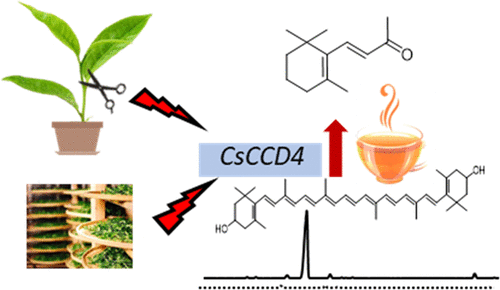当前位置:
X-MOL 学术
›
J. Agric. Food Chem.
›
论文详情
Our official English website, www.x-mol.net, welcomes your
feedback! (Note: you will need to create a separate account there.)
Carotenoid Cleavage Dioxygenase 4 Catalyzes the Formation of Carotenoid-Derived Volatile β-Ionone during Tea (Camellia sinensis) Withering.
Journal of Agricultural and Food Chemistry ( IF 5.7 ) Pub Date : 2020-02-04 , DOI: 10.1021/acs.jafc.9b07578 Jingming Wang 1 , Na Zhang 1 , Minyue Zhao 1 , Tingting Jing 1 , Jieyang Jin 1 , Bin Wu 1 , Xiaochun Wan 1 , Wilfried Schwab 1, 2 , Chuankui Song 1
Journal of Agricultural and Food Chemistry ( IF 5.7 ) Pub Date : 2020-02-04 , DOI: 10.1021/acs.jafc.9b07578 Jingming Wang 1 , Na Zhang 1 , Minyue Zhao 1 , Tingting Jing 1 , Jieyang Jin 1 , Bin Wu 1 , Xiaochun Wan 1 , Wilfried Schwab 1, 2 , Chuankui Song 1
Affiliation

|
The carotenoid-derived volatile β-ionone plays an important role in the formation of green and black tea flavors due to its low odor threshold, but its formation and the gene(s) involved in its biosynthesis during the tea withering process is(are) still unknown. In this study, we found that the content of β-ionone increased during the tea withering process catalyzed by an unknown enzyme(s). Correlation analysis of expression patterns of Camellia sinensis carotenoid cleavage dioxygenase genes (CsCCDs) and the β-ionone content during the withering period revealed CsCCD4 as the most promising candidate. The full-length CsCCD4 gene was amplified from C. sinensis, and the biochemical function of the recombinant CsCCD4 protein was studied after coexpression in Escherichia coli strains engineered to accumulate β-carotene. The recombinant protein was able to cleave a variety of carotenoids at the 9-10 and 9'-10' double bonds. Volatile β-ionone was detected as the main product by gas and liquid chromatography-mass spectrometry. The accumulation of β-ionone was consistent with the expression levels of CsCCD4 in different tissues and during the withering process. The CsCCD4 expression was induced by low temperature and mechanical damage stress but not by dehydration stress. The results demonstrate that CsCCD4 catalyzes the production of β-ionone in the tea plant and provide insight into its formation mechanism during the withering process.
中文翻译:

类胡萝卜素裂解双加氧酶4催化茶衰变过程中类胡萝卜素衍生的挥发性β-紫罗兰酮的形成。
类胡萝卜素的挥发性β-紫罗兰酮由于其气味阈值低而在绿茶和红茶风味的形成中起着重要作用,但是在凋枯过程中其形成和涉及其生物合成的基因是还是个未知数。在这项研究中,我们发现在未知的酶催化下的茶枯萎过程中,β-紫罗兰酮的含量增加了。凋谢期茶树类胡萝卜素裂解双加氧酶基因(CsCCDs)的表达方式与β-紫罗兰酮含量的相关性分析表明,CsCCD4是最有前途的候选基因。从中华假丝酵母中扩增出全长的CsCCD4基因,并在工程化后积累β-胡萝卜素的大肠杆菌中共表达重组CsCCD4蛋白的生化功能。重组蛋白能够在9-10和9'-10'双键处裂解多种类胡萝卜素。气相色谱-液相色谱-质谱法检测到挥发性β-紫罗兰酮为主要产物。β-紫罗兰酮的积累与枯萎过程中不同组织中CsCCD4的表达水平一致。CsCCD4表达是由低温和机械损伤应力诱导的,而不是由脱水应力诱导的。结果表明,CsCCD4催化茶树中β-紫罗兰酮的产生,并为枯萎过程中其形成机理提供了见识。β-紫罗兰酮的积累与枯萎过程中不同组织中CsCCD4的表达水平一致。CsCCD4表达是由低温和机械损伤应力诱导的,而不是由脱水应力诱导的。结果表明,CsCCD4催化茶树中β-紫罗兰酮的产生,并为枯萎过程中其形成机理提供了见识。β-紫罗兰酮的积累与枯萎过程中不同组织中CsCCD4的表达水平一致。CsCCD4表达是由低温和机械损伤应力诱导的,而不是由脱水应力诱导的。结果表明,CsCCD4催化茶树中β-紫罗兰酮的产生,并为枯萎过程中其形成机理提供了见识。
更新日期:2020-02-04
中文翻译:

类胡萝卜素裂解双加氧酶4催化茶衰变过程中类胡萝卜素衍生的挥发性β-紫罗兰酮的形成。
类胡萝卜素的挥发性β-紫罗兰酮由于其气味阈值低而在绿茶和红茶风味的形成中起着重要作用,但是在凋枯过程中其形成和涉及其生物合成的基因是还是个未知数。在这项研究中,我们发现在未知的酶催化下的茶枯萎过程中,β-紫罗兰酮的含量增加了。凋谢期茶树类胡萝卜素裂解双加氧酶基因(CsCCDs)的表达方式与β-紫罗兰酮含量的相关性分析表明,CsCCD4是最有前途的候选基因。从中华假丝酵母中扩增出全长的CsCCD4基因,并在工程化后积累β-胡萝卜素的大肠杆菌中共表达重组CsCCD4蛋白的生化功能。重组蛋白能够在9-10和9'-10'双键处裂解多种类胡萝卜素。气相色谱-液相色谱-质谱法检测到挥发性β-紫罗兰酮为主要产物。β-紫罗兰酮的积累与枯萎过程中不同组织中CsCCD4的表达水平一致。CsCCD4表达是由低温和机械损伤应力诱导的,而不是由脱水应力诱导的。结果表明,CsCCD4催化茶树中β-紫罗兰酮的产生,并为枯萎过程中其形成机理提供了见识。β-紫罗兰酮的积累与枯萎过程中不同组织中CsCCD4的表达水平一致。CsCCD4表达是由低温和机械损伤应力诱导的,而不是由脱水应力诱导的。结果表明,CsCCD4催化茶树中β-紫罗兰酮的产生,并为枯萎过程中其形成机理提供了见识。β-紫罗兰酮的积累与枯萎过程中不同组织中CsCCD4的表达水平一致。CsCCD4表达是由低温和机械损伤应力诱导的,而不是由脱水应力诱导的。结果表明,CsCCD4催化茶树中β-紫罗兰酮的产生,并为枯萎过程中其形成机理提供了见识。











































 京公网安备 11010802027423号
京公网安备 11010802027423号